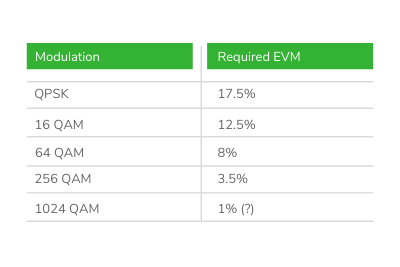Blog: How to choose oscillators for your 5G small cell deployment

With higher spectral frequencies and shorter reach, 5G networks are much denser than previous generations. Superfast 5G backhaul (mmWave) relies greatly on small cells, not just for coverage but also for speed. On top of this, initiatives such as the O-RAN alliance open up the RAN ecosystem with more choices, but at the same time, add more complexity. Since timing and synchronisation are very important in 5G networks, design engineers face some difficult decisions.
This article will explain what to look for in 5G small cell oscillators to get the best result for your application requirement.
1. Dynamic performance requirement
The first thing to look at is the dynamic clock performance. The key requirement with 5G is the need for high phase alignment (130ns). In comparison, previous generation networks require only 1.5µs. With such tight requirements, delivering synchronisation in the traditional way becomes challenging. The need to provide 50ppb stability at any point of time and measured in 1ms intervals on the air interface, demands filtering on the physical layer and the packet layer to be much narrower than for generic transport equipment. The servo clock bandwidths on the end nodes are narrow to support the specific scenarios and requirements:
- Support for GNSS clocks: GNSS clocks have 1PPS support requirements. 1PPS inputs into a servo system use very low bandwidths, usually 10–30mHz
- Support for SyncE filtered frequency: Considering the standard network noise, SyncE clocks require low bandwidth filtering such as 10–50mHz, to support 50ppb accuracy at the air interface
- Support for no on-path supported networks requires very low bandwidth and can usually be below the mHz range.
Once the filtering happens at such low bandwidths, the impact of intrinsic noise of the system (which comes mainly from the oscillator) comes into play. What becomes important now is the temperature sensitivity performance when compared to the absolute frequency variations. Therefore when selecting a small cell oscillator choose the correct sensitivity performance for your particular temperature range. Generally, this is 0.1 – 0.5 ppb/°C.
2. Holdover
Holdover is the ability of the system to maintain synchronisation within acceptable limits when the primary source of synchronisation (often a GNSS signal) is lost. The specific holdover requirements are stipulated by the operator based on their service levels, although industry initiatives such as O-RAN provide guidance on specifications as well as providing some common designs.
Holdover is mainly affected by the following issues (there are others but they have less impact):
- Servo initial error: Holdover might happen at any instant of operation over the servo system. At that instant, the error of the system is classified as the initial error. The servo system should be providing <1ns phase error and <1ppt error on frequency accuracy
- Temperature variation: Temperature variation is solved by choosing a high stability (FvT) oscillator. Generally, a 1ppb oscillator drifts about 1ns in every second. The absolute variation on its own needs to be below 0.1ppb to achieve a target variation of 1.5µs for 4 hours over the operating temperature range
- Ageing drift: Ageing is the systematic variation that happens to the resonator which results in long term variation. It is usually referred to as a per day variation. For a 4-hour holdover target, the value is recommended to be below 0.2ppb/day
- Hysteresis and other system effects: The frequency difference that the resonator accumulates over temperature cycles is referred to as the hysteresis effect. The hysteresis effect and other system effects can cause power supply variations and load variations. This, in turn, affects the holdover. For a 4-hour holdover target, these effects should be lower than 0.1ppb.
- Random variations: Due to the nature of the resonator, frequency drift can be caused by random effects, i.e. other than temperature or ageing. This random frequency drift is to be lower than 0.1ppb for a 4-hour holdover target.
Want to calculate holdover for your chosen oscillator? Try our new holdover simulator app now!
3. Phase Noise
Another aspect of clocks in 5G small cells is the requirement for low phase noise at the radio sections. To achieve the highest modulation rates (256 QAM and beyond), 5G requires very low phase noise contribution to EVM (error vector magnitude) from reference clocks*.
The measure of deviation of the actual constellation of a phase-modulated vector from its ideal location is called Error Vector Magnitude. One of the key contributors of large EVM is the phase noise of the reference clock of the system. As the phase noise of the clocks that drive the radios is reduced, the contribution to EVMs is reduced, resulting in higher levels of modulation. 3GPP has specified the EVM limits on QAM modulation as per the following table.
 Fig.1: 3GPP EVM limits on QAM modulation
Fig.1: 3GPP EVM limits on QAM modulation
4. Other technical factors that influence your choice of small cell oscillator
There are two technical factors that drive components inside the radios – including the oscillators – to operate within increasing temperature ranges. Firstly, outdoor small cell packaging is generally completely sealed and uses no fan. Secondly, larger MIMO architectures demand high power, which raises the temperature in small cell equipment. Currently, with 5G, small cell oscillators must withstand temperatures up to 105°C compared to the traditional 85 °C.
Additionally, outdoor radio deployments roadside and on street poles are required to withstand a certain level of vibration.**
5. High-performance oscillators for large scale deployments
5G, with its higher frequency spectrum, has a more dense deployment of radios and small cells compared to previous generations of cellular technologies. While small cells are a cost-effective solution to create better coverage and speed, like base stations, they do need to be equipped with high performance, high-reliability reference clocks with a long lifetime.
When choosing a provider of high-performance oscillators it is worth considering a partner that can meet this large volume demand consistently and whether they have a reliable multi-source ecosystem of suppliers and manufacturing partners.
Conclusion
With 5G networks becoming a reality, network synchronisation has become more important and more complex. There are many design scenarios for small cell implementations, each of which have specific oscillator requirements. Please talk to us if you would like to find out more about the oscillator requirements for your particular design or to know more about our 5G small cell optimised oscillators.
* For Rakon’s VCXOs designed to be within these limits, you will find this information in the product datasheets.
** Using its new XMEMS® technology, Rakon has developed oscillators with a low vibration sensitivity that is well within the requirements.
Would you like more content like this delivered to your inbox?
Subscribe to our emails now!
